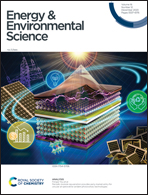Moisturized 2-dimensional halide perovskite generates a power density of 30 mW cm−3†
Abstract
Apart from the photovoltaic effect, we report here for the first time on the ionovoltaic effect of 2-dimensional (2D) halide perovskite located between vertically installed electrode structures, generating electricity by absorbing moisture. Benefiting from the hydrophilic and ionic nature of the 2D perovskite of EOA2PbI4 (EOA = ethanolammonium), the device with an ∼1.67 μm-thick perovskite film produces a voltage of ca. 0.7 V and a current density of 26.7 μA cm−2, leading to a power density of ∼30 mW cm−3 which is more than 7 times higher than the reported best value (∼4.2 mW cm−3) so far. Combined experimental and theoretical studies found that the interaction between the water molecules and the perovskite layers is the key to electricity generation, which can form a self-maintained moisture gradient and a corresponding ion gradient. A topotactic adsorption–desorption reaction is observed, indicating that the 2D perovskite structure is maintained even after the removal of moisture. This new perovskite ionovoltaic device and its excellent capability to harvest energy from atmospheric moisture are expected to open new opportunities for exploiting the novel properties of organic–inorganic hybrid halide perovskite.



 Please wait while we load your content...
Please wait while we load your content...